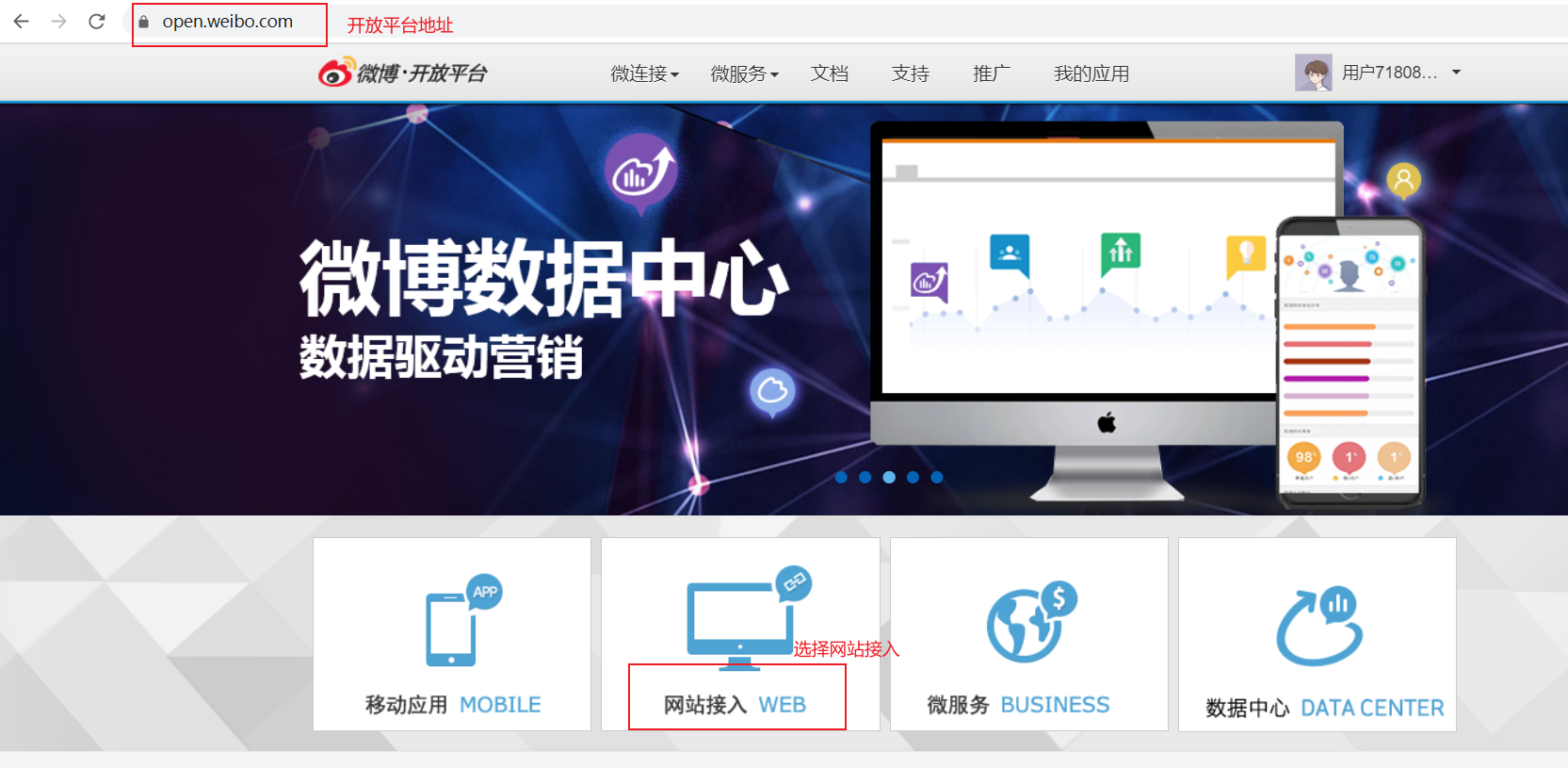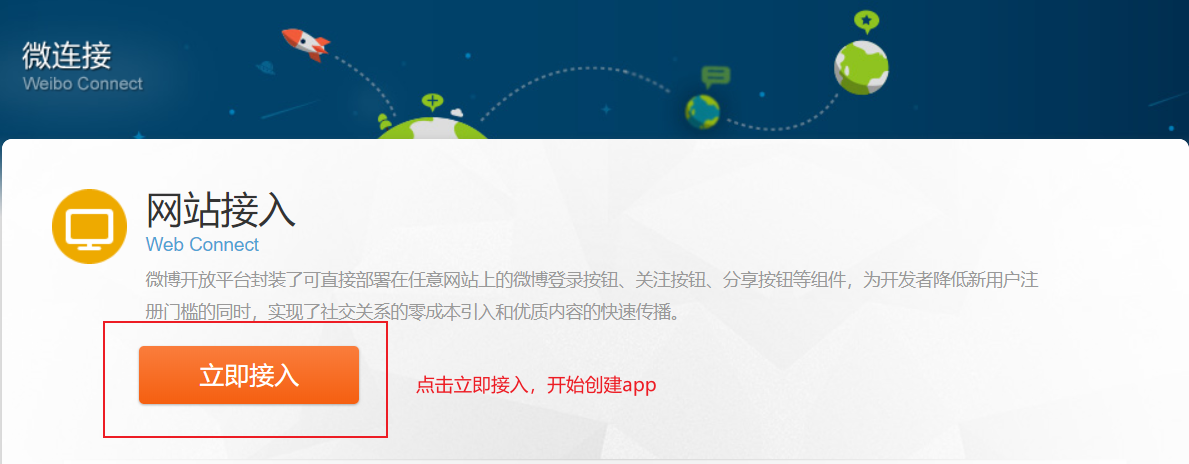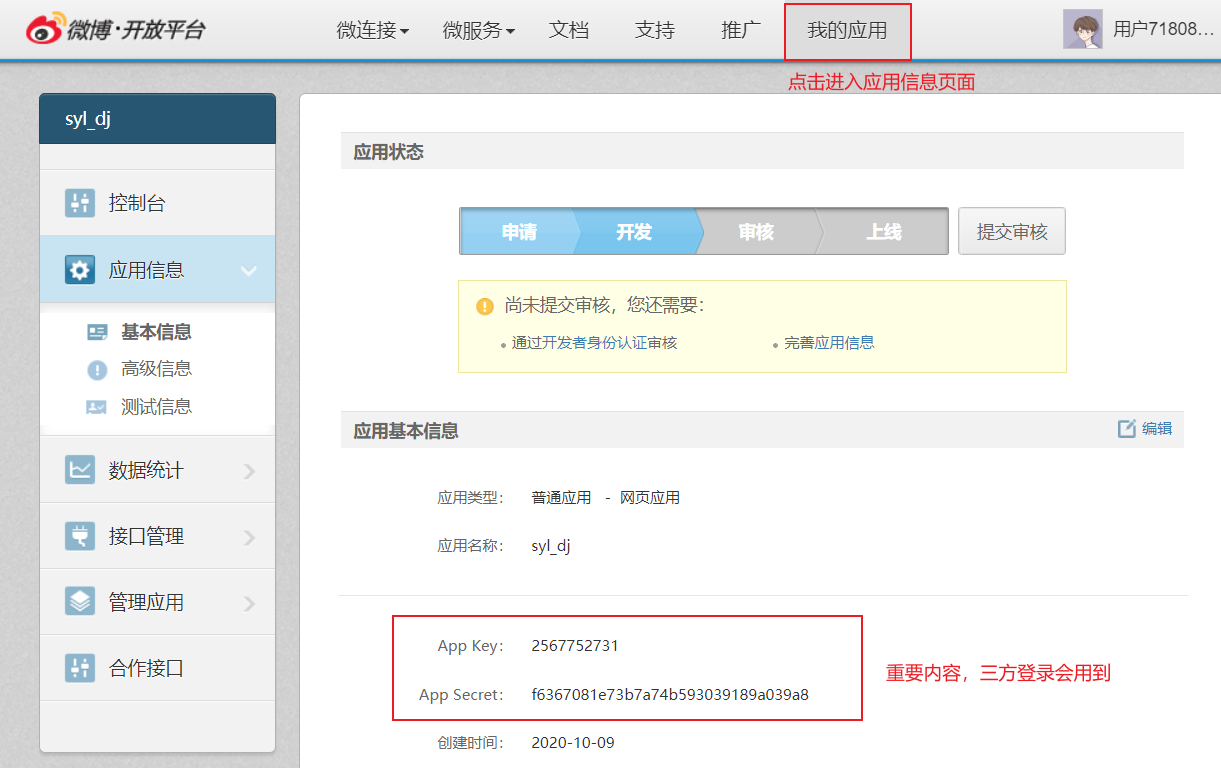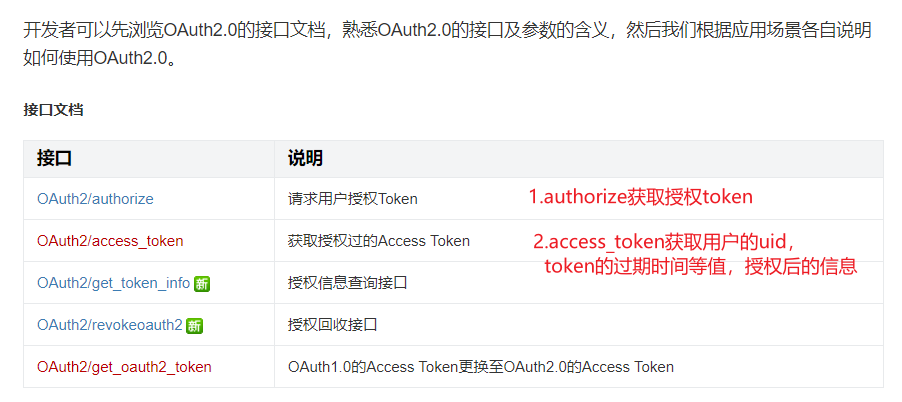微博三方登录
1.注册账号
注册新浪微博账号
进入首页,创建网站接入的应用:https://open.weibo.com/

选择立即接入,进入到创建应用页面

创建应用

基本信息页面

高级信息页面

- 接口文档
查看接口文档


OAuth2.0授权认证
接口 说明
OAuth2/authorize 请求用户授权Token
OAuth2/access_token 获取授权过的Access Token,UID
OAuth2.0授权认证
接口 说明
OAuth2/authorize 请求用户授权Token
OAuth2/access_token 获取授权过的Access Token,UID
3 三方登录实战
3.1 生成微博授权URL接口
3.1.1 在apps文件夹下创建应用oauth
cd syl/apps
python ../manage.py startapp oauth
3.1.2 添加子路由
from django.urls import path
from . import views
urlpatterns = [
]
3.1.3 在syl/settings.py中注册应用
INSTALLED_APPS = [
'oauth.apps.OauthConfig',
]
3.1.4 在syl/urls.py主路由中添加
urlpatterns = [
path('oauth/', include('oauth.urls'))
]
3.2 生成微博授权URL接口
3.2.1 添加子路由oauth/urls.py
# -*- coding: utf-8 -*-
from django.urls import path
from . import views
urlpatterns = [
path('weibo/', views.WeiboUrl.as_view()), # /oauth/weibo/ 返回微博登录地址
]
3.2.2 sul/settings.py中配微博地址
# 微博
WEIBO_CLIENT_ID = '1685526621'
WEIBO_REDIRECT_URL = 'http://127.0.0.1:8888/oauth/callback/'
WEIBO_CLIENT_SECRET = '71a62fe7cb582143aaf8e05dd4a0fc0c'
3.2.3 视图函数oauth/views.py
from rest_framework.permissions import AllowAny
from rest_framework.response import Response
from rest_framework.views import APIView
from urllib.parse import urlencode
# 生成前端跳转到微博扫码页面的url
from syl import settings
from user.models import User
class WeiboUrl(APIView):
'''
生成微博的登陆页面路由地址
https://api.weibo.com/oauth2/authorize? # 微博oauth认证地址
client_id=4152203033& # 注册开发者id
response_type=code& redirect_uri=http:/``/127.0.0.1:8888/oauth/callback/ # 获取code后将code回 调给后端地址
'''
# 自定义权限类
permission_classes = (AllowAny,)
def post(self, request):
url = 'https://api.weibo.com/oauth2/authorize?' # 微博授权的 url地址
data = {
'client_id': settings.WEIBO_CLIENT_ID, # settings.WEIBO_CLIENT_ID
'response_type': 'code',
'redirect_uri': settings.WEIBO_REDIRECT_URL, # VUE的回调,微博后台授权的回调地址
}
print(urlencode(data))
weibo_url = url + urlencode(data)
# https://api.weibo.com/oauth2/authorize? client_id=4152203033&response_type=code&redirect_uri=http://127.0.0.1:8000/api/we ibo_back/
# return Response({'weibo_url': weibo_url})
return Response({'code': '0', 'msg': '成功', 'data': {'url': weibo_url}})
3.3 Vue获取微博授权URL
3.3.1 在 components\common\lab_header.vue 中写oauth动态获取微博授权URL
<tamplate>
<div>
<a @click="oauth"><i class="fa fa-weibo"></i></a>
</div>
</tamplate>
<script>
import { oauth_post } from '../axios_api/api'
export default{
methods: {
// 获取微博登录地址
oauth() {
// 从后端获取 微博登录地址
oauth_post().then((resp) => {
console.log(resp)
//{'code': '0', 'msg': '成功', 'data': {'url': url}}
let url = resp.data.url;
this.weibo_url = url;
})
},
}
</script>
3.3.2 在vue的mounted函数中调用获取微博授权url函数
mounted() {
this.oauth()
},
3.3.3 点击"登录"弹出的form表单中加入url
<form
action="/login"
method="post"
>
<div class="form-group widget-signin">
<a :href="weibo_url"><i class="fa fa-weibo"></i></a>
</div>
</form>
3.4 微博回调接口
3.4.1 oauth/urls.py
# -*- coding: utf-8 -*-
from django.urls import path
from . import views
urlpatterns = [
path('weibo/callback/', views.OauthWeiboCallback.as_view()), # /oauth/weibo/callback/查询三方表,有绑定信息返回登录成功,没有绑定信息返还uid
]
3.4.2 oauth/models.py
from django.db import models
# Create your models here.
# 把三方的用户信息,和本地的用户信息进行绑定
#
class OauthUser(models.Model):
OAUTHTYPE = (
('1', 'weibo'),
('2', 'weixin'),
)
uid = models.CharField('三方用户id', max_length=64) # 三方用户id
user = models.ForeignKey('user.User', on_delete=models.CASCADE) # 本地用户外键,关联User表
oauth_type = models.CharField('认证类型', max_length=10, choices=OAUTHTYPE) # 1,2 ...
# 迁移数据库
# python manage.py makemigrations
# python manage.py migrate
3.4.3 oauth/views.py
from oath.models import OauthUser
from rest_framework_jwt.serializers import jwt_payload_handler, jwt_encode_handler
from user.utils import jwt_response_payload_handler
# 通过vue前端传入的code,微博身份验证
class OauthWeiboCallback(APIView):
# 自定义权限类
permission_classes = (AllowAny,)
def post(self, request):
# 接收vue端传过来的code(微博的用户code)
# 1.使用微博用户code+微博开发者账号信息换取微博的认证access_token
code = request.data.get('code')
data = {
'client_id': settings.WEIBO_CLIENT_ID,
'client_secret': settings.WEIBO_CLIENT_SECRET,
'grant_type': 'authorization_code',
'code': code,
'redirect_uri': settings.WEIBO_REDIRECT_URL,
}
url = 'https://api.weibo.com/oauth2/access_token'
data = requests.post(url=url, data=data).json()
print(data)
# 拿取请求的返回结果
# access_token = data.get('access_token')
# 获取到的微博token
weibo_uid = data.get('uid')
# 获取到少码用户的id
# 2. 根据uid 查询绑定情况
try:
oauth_user = OauthUser.objects.get(uid=weibo_uid, oauth_type='1')
except Exception as e:
oauth_user = None # 返回动作, 登录成功/需要绑定用户 type 0 登录成功, 1, 授权成功, 需要绑定
if oauth_user:
# 4. 如果绑定了, 返回token, 登录成功
user = oauth_user.user
payload = jwt_payload_handler(user)
token = jwt_encode_handler(payload)
# jwt_response_payload_handler为user模块定义的jwt返回的信息
data = jwt_response_payload_handler(token, user)
data['type'] = '0' # 指定为登录成功
return Response({'code': 0, 'msg': '登录成功', 'data': data})
else:
# 5. 如果没绑定, 返回标志, 让前端跳转到绑定页面
print(weibo_uid)
return Response({'code': 0, 'msg': '授权成功', 'data': {'type': '1', 'uid': weibo_uid}})
3.5 Vue微博回调空页面
- 注:回调空页面为:http://127.0.0.1:8888/oauth/callback/
- 页面路径 components\oauth.vue
<template>
<div>
<div v-show='visiable'>
绑定用户
用户名: <input
type="text"
v-model="username"
@blur="check_username"
>
<span>{{username_message}}</span>
密码: <input
type="password"
v-model="password"
>
<button @click="bindUser">绑定</button>
</div>
</div>
</template>
<script>
import { oauth_callback_post, oauth_binduser_post, user_count } from './axios_api/api'
export default {
data() {
return {
visiable: false, // 绑定用户窗口
uid: '', // weibo_uid
username: '',
password: '',
username_message: '',
username_error: false
}
},
mounted() {
this.getCode()
},
methods: {
// 2.判断用户名是否合法
check_username() {
console.log('判断用户名')
console.log(this.username == '')
var reg = new RegExp(/^[a-zA-Z0-9_-]{3,16}$/); //字符串正则表达式 4到14位(字母,数字,下划线,减号)
if (this.username == '') {
this.username_message = '用户名不能为空'
this.username_error = true
return false
}
if (!reg.test(this.username)) {
this.username_message = '用户名格式不正确'
this.username_error = true
return false
} else {
// 去后端检查用户名使用数量
user_count({ type: 'username', data: this.username }).then((res) => {
console.log(res)
if (res.data.count > 0) {
this.username_message = '用户名已存在, 请输入密码'
this.username_error = false
} else {
this.username_message = '用户名可用, 将创建新用户,请输入密码'
this.username_error = false
}
})
}
},
// 1.1当页面被挂载时就自动调用,通过url获取微博的code,发送code给django端
// 1.2 如果已经绑定,返回 type='0',登录成功,直接跳转到首页
// 1.3 如果未绑定,返回type='1',显示绑定用户的页面
getCode() {
// 获取url中的code 信息,code信息是微博端返回的
// 当前url 是 http://127.0.0.1:8888/oauth/callback/?code=424db5805abb50ed5e0ba97325f54d0f
let code = this.$route.query.code
console.log(this.$route.query)
// 给后端发送code
let params = { code: code }
oauth_callback_post(params).then((resp) => {
console.log(resp)
// code: 0
// msg: "授权成功"
// data: {type: "1", uid: "7410919278"}
// 如果type=0代表以前已经绑定过,直接登录成功
if (resp.data.type == '0') {
// code: 0
// msg: "登录成功"
// data: {
// authenticated: "true"
// email: ""
// id: 1
// name: "admin"
// role: null
// token: "eyJ0eXAiOiJKV1QiLCJhbGciOiJIUzI1NiJ9.eyJ1c2VyX2lkIjoxLCJ1c2VybmFtZSI6ImFkbWluIiwiZXhwIjoxNTk3OTAwNTcyLCJlbWFpbCI6IiIsIm9yaWdfaWF0IjoxNTk3ODE0MTcyfQ.aQT7GSR_xQBPMlB4_k8-zTHnx0ow3OC2KHa3C8MgilY"
// type: "0"
// username: "admin"}
let res = resp.data
localStorage.setItem('username', res.username)
// localStorage.setItem('img', res.img)
localStorage.setItem('token', res.token)
localStorage.setItem('uid', res.id)
this.login_username = res.username
this.opened = false
// alert(res.message)
this.$router.push('/') // 跳转到首页
}
// 如果用户·没有绑定过,显示绑定页面
if (resp.data.type == '1') {
this.visiable = true
this.uid = resp.data.uid
}
})
},
// 3.绑定微博用户与实验楼本地用户
bindUser() {
if(this.username_error){
return
}
// 发送 用户名, 密码, weibo_uid 到后端接口, 进行绑定
let params = { username: this.username, password: this.password, weibo_uid: this.uid }
oauth_binduser_post(params).then((resp) => {
console.log(resp)
let res = resp.data
localStorage.setItem('username', res.username)
// localStorage.setItem('img', res.img)
localStorage.setItem('token', res.token)
localStorage.setItem('uid', res.id)
this.login_username = res.username
this.opened = false
// alert(res.message)
this.$router.push('/')
})
}
}
}
</script>
3.6 微博绑定用户接口
3.6.1 oauth/urls.py
urlpatterns = [
path('weibo/binduser/', views.OauthWeiboBindUser.as_view()), # /oauth/weibo/callbac
]
3.6.2 oauth/views.py
class OauthWeiboBindUser(APIView):
permission_classes = (AllowAny,)
def post(self, request):
# 绑定用户, 1. 已注册用户, 2. 未注册用户
# 1.1 获取用户名, 密码, weibo_uid
username = request.data.get('username')
password = request.data.get('password')
weibo_uid = request.data.get('weibo_uid')
if not all([username, password, weibo_uid]):
return Response({'code': 999, 'msg': '参数不全'})
# 0.判断是否存在此用户
try:
user = User.objects.get(username=username)
except Exception as e:
user = None
# 1. 已注册用户
if user:
# 1.2 , 如果存在就验证 密码, 验证通过,就绑定, 返回token,登录成功
if user.check_password(password):
ou = OauthUser(uid=weibo_uid, user=user, oauth_type='1')
ou.save()
payload = jwt_payload_handler(user)
# 通过user对象获取到jwt的 payload信息
token = jwt_encode_handler(payload)
# 生成token
data = jwt_response_payload_handler(token, user)
data['type'] = '0'
# 指定为登录成功
return Response({'code': 0, 'msg': '登录成功', 'data': data})
else:
return Response({'code': 999, 'msg': '密码错误'})
else:
# 2. 未注册用户
# 2.1 生成新用户, 设置用户名密码, 保存, 然后绑定, 返回token, 登录成功
user = User(username=username)
user.set_password(password)
user.save()
ou = OauthUser(uid=weibo_uid, user=user, oauth_type='1')
ou.save()
payload = jwt_payload_handler(user)
token = jwt_encode_handler(payload)
data = jwt_response_payload_handler(token, user)
data['type'] = '0'
# 指定为登录成功
return Response({'code': 0, 'msg': '登录成功', 'data': data})
3.7 Vue绑定用户页面
- 同回调空页面



